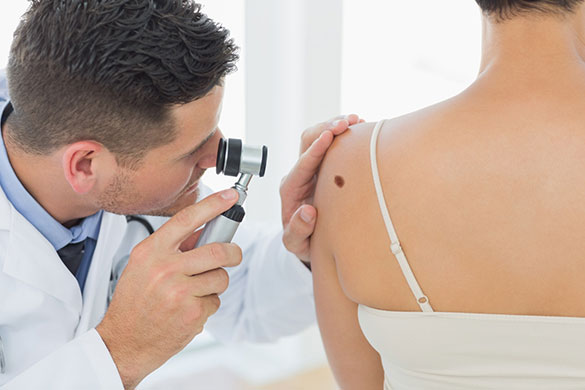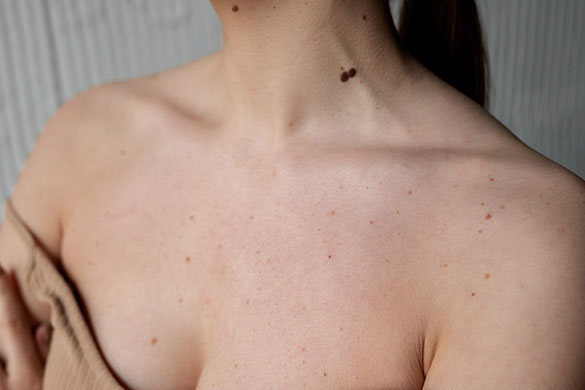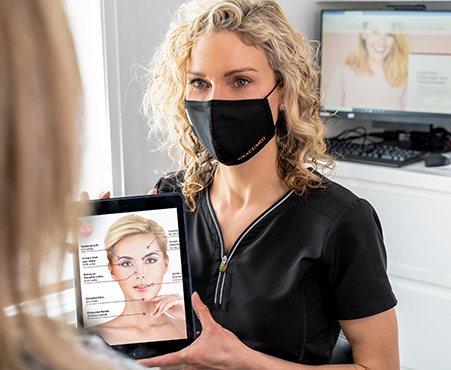
Melanoma is the most severe type of skin cancer that develops in the cells that produce melanin (the pigment that gives the skin its colour). Although melanoma is mainly seen on the skin, it can also appear in the eyes and rarely inside the body, such as in the throat or nose. It’s essential to understand what is melanoma and learn how to identify melanoma symptoms to choose a suitable treatment.
The Canadian Cancer Society estimates that 9,000 Canadians will be diagnosed with melanoma skin cancer in 2022. Unfortunately, skin cancer melanoma is fatal if left untreated, especially because it can escalate to extreme stages. It would help if you took precautions to reduce your risk of melanoma by applying sunscreen frequently, as it can protect your skin from the sun’s harmful UV rays.
If you’re developing signs of melanoma, it’s important to visit a medical professional and perform skin cancer screening to determine if they are symptoms of skin cancer melanoma. You can also visit one of the GraceMed dermatology clinics to speak to a specialist and determine if your skin condition is melanoma or something more minor. If our dermatologists examine your skin and identify melanoma cancer, they may suggest you visit a skin cancer specialist.
What is Skin Cancer Melanoma
Skin cancer or malignant melanoma starts when cells in the body begin to grow out of control. Cells in almost any part of the body can become cancer and spread to other areas of the body. Melanoma skin cancer can spread to other body parts or be fatal if not identified and appropriately treated.
Most skin cancers start in the top layer of the skin, referred to as the epidermis. The three main types of cells in this layer are squamous cells, basal cells, and melanocytes. If you identify early stage melanoma before the skin cancer becomes more advanced and grows through this barrier and into the deeper layers, you might be able to treat it safely and stop it from spreading.

What Does Melanoma Look Like
Malignant melanoma cancer may look different in every stage. During the first stage, you may notice melanoma spots, typically moles that change in size, shape, or colour. You can use the “ABCDE” rule to identify and remember the warning signs of skin melanoma.
- Asymmetry (A): Most melanomas are asymmetrical, and the shape of one half of the mole usually does not match the other.
- Border (B): Skin melanoma borders tend to be uneven as the edges are notched or blurred, whereas common moles have smooth and even borders.
- Colour (C): Benign moles are usually a single shade of brown. However, skin cancer melanoma can appear in multiple colours, such as different shades of brown, tan, or black. Some areas may also appear white, gray, red, or blue.
- Diameter (D): Skin melanoma might be small when first detected but can continue to grow in size. The diameter is usually larger than 6 millimetres (mm), which is 1/4 inch in diameter.
- Evolving (E): Any change in shape, size, colour, or elevation of a melanoma spot is one of the most common melanoma symptoms. You may also experience changes in feeling, as melanoma can be itchy, bleeding, or crusting.
Signs of Melanoma
If you want to ensure that you can treat melanoma in its early stages, it’s essential to learn how to identify the warning signs of malignant melanoma cancer.
Changes in Existing Mole
If you have moles on your skin that you suspect might be melanoma spots, make it a habit to self-examine your skin every month. The sooner you identify any changes, the earlier you can seek melanoma treatment.
One of the first warning signs of melanoma cancer is any changes in the existing mole. You can use the ABCDE rule to identify changes and seek medical care accordingly.
Development of Unusual Growth
If you’re developing melanoma, you may notice dome-shaped growths on your skin that feel firm and look like a sore but might bleed. The growth might also be itchy and painful, which are common indicators that you need to seek melanoma treatment immediately. When looking for the ideal treatment for melanoma, consult a medical professional for safe results. You can visit a GraceMed dermatologist in North York or other cities in the GTA to determine if your growth is a warning sign of melanoma cancer.

Pigmented Skin
Pigmentation is a change in skin colour that occur from skin damage. If you notice certain areas of your skin getting pigmented, it is important to go for cancer screening to confirm or rule out the possibility of malignant melanoma skin cancer. Pigmented skin can be uncomfortable even if not a result of melanoma skin cancer. Sometimes pigmentation can occur due to extreme sun exposure or as a reaction to certain products. Once you’ve determined the cause of pigmentation, if it isn’t occurring due to skin melanoma, you can try one of the many skin care treatment options at GraceMed. Sometimes people also choose to treat pigmentation for cosmetic purposes.
A few skin pigment disorders can affect one’s skin and confidence. Each pigmentation cause has its own treatment. However, skin melanoma is one of the most harmful forms of pigmentation and should be treated promptly to reduce spreading.
Swelling Beyond Border of Mole
Normal moles on the body are typically a uniform colour with a distinct border separating the mole from the remainder of your skin. However, when melanoma spots start to swell beyond the border of a mole, it could be skin cancer, and you should seek treatment for melanoma immediately.
Most moles appear in childhood, and some new ones may appear until age 40. Some regular moles may slightly change their appearance or disappear with time. But, one of the warning signs of melanoma moles is a drastic change in appearance, especially beyond the mole’s border.
Symptoms of Melanoma
Along with the early warning signs of melanoma, it’s equally important for you to identify melanoma symptoms before they escalate and become challenging to treat.
Bump/Sore/Rash That Doesn’t Heal
When a bump, sore, or rash on your skin isn’t healing with time or treatment, it could be a symptom of melanoma skin cancer. Any mole or lesion that looks unusual and isn’t going away with time should be screened for cancer immediately. You can self-screen your skin frequently by observing any bumps or growths. However, seeking professional care is vital before the matter worsens and spreads to other organs.
Itchy or Tender Nodules Under the Skin
Although skin melanoma is visibly over the skin, you might feel itchy or tender nodules under the skin. If any part of your skin starts to feel uncomfortable, even if there is no visible bump, visit a skin specialist to determine the cause of the discomfort.
It’s important to wear sunscreen whenever you go under the skin to prevent skin damage. When the harmful UV rays penetrate your sun, you’ll develop various skin problems, including melanoma. Make sure to choose a broad-spectrum sunscreen with an SPF of at least 30 to ensure that the cream does its job effectively.

Swelling, Pain or Redness
One of the most common indicators of melanoma spots is swelling, pain, or redness. A regular bump or growth may feel uncomfortable temporarily, but it is rare for it to swell, cause extreme discomfort, or continuously maintain a red appearance.
Headaches or Seizures
When melanoma spreads from the skin to another part of the body, it is referred to as metastatic melanoma. The disease occurs when cancerous cells from the primary tumour get loose, travel through the lymph or blood circulation, and start a new tumour in a new location.
This type of melanoma usually occurs in stage three or four, and the melanoma symptoms might differ in this case. When melanoma spreads to the brain, you’ll get more frequent headaches and may experience seizures. It’s crucial to seek treatment immediately to prevent cancer from spreading further.
Fractures or Bone Pain
As mentioned above, skin melanoma spreads to other body parts and can also affect the bones. If melanoma is left untreated, it can affect your bones and lead to fractures or pain.
Loss of Appetite or Unexpected Weight Loss
Melanoma can also affect the liver if it spreads beyond the skin. In this case, one of the most common symptoms of melanoma is unexpected weight loss. If you have an untreated growth on your skin and notice yourself losing weight without trying, visit a medical professional immediately.
Stages of Melanoma
Cancer staging is how a healthcare provider determines the extent of cancer in your body. It’s essential to identify which stage of melanoma you’re in to choose the proper treatment.
Stage 0 Melanoma
In the early stages of melanoma, the tumour is still confined to the upper layer of the skin. In this stage, the tumour is in the outer layer of the skin and has not grown more profound into the dermis. Sometimes, summer damage from the sun can result in stage 0 melanoma, but the proper treatment can reduce its impact and stop it from growing.
Stage 1 Melanoma
At stage 1, melanoma cancer cells start forming in both the skin’s outer and inner layers. The melanoma has not reached the lymph nodes or distant sites (metastasis) during this stage. Seeking malignant melanoma treatment early on can prevent cancer from spreading. Melanoma stage 1 treatment usually involves wide excision, a surgery to remove the melanoma and a margin of normal skin surrounding it.
Stage 2 Melanoma
When the tumour thickens and extends beyond the outer layer of the skin and deeper into the inner layer, it reaches stage 2. You may notice more prevalent melanoma spots in this stage. The melanoma is more likely to metastasize in this stage and requires immediate treatment to prevent it from spreading to lymph tissues, lymph nodes, or body organs.

Stage 3 Melanoma
Stage 3 is one of the more advanced stages of melanoma, during which cancer has spread to one or more regional lymph nodes. It may have also developed a melanoma deposit in the skin or dermis. It’s crucial to seek treatment for melanoma at this stage if cancer hasn’t been treated already.
Stage 4 Melanoma
In stage 4 of melanoma cancer, cancer has spread beyond the original tumour site and has likely affected more distant areas of the body. This may include distant skin, lymph nodes, bones, lungs, and liver. Although this is the most advanced stage of the disease, you can still consult a medical professional and seek melanoma treatment.
Melanoma Treatment Options
There are a few melanoma treatment options that you can consider to prevent the tumour from spreading or growing.
Surgery to Remove Tumor
Surgery is the definitive treatment for early-stage malignant melanoma. You might have a mole if you notice pigmentation that isn’t cancerous. Depending on the stage, doctors may apply a few treatment methods to treat melanoma skin cancer. Some options include wide local excision, sentinel lymph node biopsy (SLNB), and complete lymph node dissection
If your doctor has ruled out melanoma cancer, you can visit GraceMed for mole removal in Oakville and consult our expert team of dermatologists, plastic surgeons, nurses, and medical aestheticians from the most prestigious medical institutions in the country.
In addition, you can also consider a range of facial treatments offered at GraceMed to help improve the look of scarring after the surgical malignant melanoma treatment.
Skin Grafting
You may need skin grafting with a skin flap or graft if your surgeon removes a large portion of cancerous skin during surgery. This procedure can improve melanoma spots after a surgical procedure is performed. After skin melanoma is removed, the grafting process will include using skin from another part of your body to repair the affected area.

Chemotherapy
Chemotherapy uses anticancer (cytotoxic) drugs to destroy cancer cells and is sometimes used as a melanoma treatment. Your doctor may recommend chemotherapy to stop or control the growth and spread of cancer cells, shrink a tumour, relieve pain, or control the symptoms of advanced melanoma skin cancer.
Immunotherapy
If a biopsy shows that the melanoma has spread to lymph nodes, surgery may not be as effective, during which immunotherapy might be the appropriate melanoma treatment. Cancer immunotherapy is a class of treatments that uses a patient’s own immune system to help kill cancer cells. There are several FDA-approved immunotherapy options for melanoma that specialists may use.
The Importance of Melanoma Skin Cancer Treatment
Melanoma accounts for the vast majority of deaths caused by skin cancer, so it is important to seek treatment as soon as possible. If you have any unusual growths or bumps on the skin, you can visit one of GraceMed’s clinics to determine your next step.

